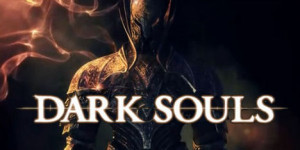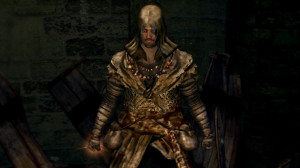 Spoiler warning: Some details of the story of Dark Souls will be discussed in this article.
Spoiler warning: Some details of the story of Dark Souls will be discussed in this article.
Recently, I’ve been playing a game called Dark Souls 2. For those who are not familiar with the game , it is an action RPG for the Playstation 3, Xbox 360, and PC. The series is primarily known for its tough-but-fair difficulty and well-designed combat. For those who really delve into the Dark Souls games, however, it can be seen that the designers have put together a complex plot filled with ambition, tragedy, and the manipulation of the main character… and thus, the player.
It’s a pretty cool story. What is more interesting, though, is how the story is told. Most games and game masters tend to inform players of the world’s backstory through narration, NPCs, or an out-of-game information dump. In Dark Souls, however, direct information is scarce. Discounting the introductory cut-scene, there is no real narration of the state of the world or the people in it. Those who want to know what is going on need to pay attention to the world around them. Is this character trustworthy? Why did I find this item here, and why does this corpse have it? For that matter, what is this item? Every item has a short description. Some of them only describe the item’s function and provide a physical description. Other items, however, have a few lines that are related to their origin, such as the “Armor of Artorias:”
 “Armor of Artorias the Abysswalker, one of Gwyn’s four knights. The death of the armor’s owner can be surmised from the corrosive Dark of the Abyss, and the tattered azure-blue cape, once a symbol of pride and glory.”
“Armor of Artorias the Abysswalker, one of Gwyn’s four knights. The death of the armor’s owner can be surmised from the corrosive Dark of the Abyss, and the tattered azure-blue cape, once a symbol of pride and glory.”
By itself, this doesn’t mean much. Artorias was apparently some proud knight of this Gwyn. However, by discovering other artifacts, exploring environments, and applying some critical thinking, players can learn who Artorias and Gwyn are, their significance to the world, how the armor came to be left behind, and what happened to that pair of NPCs.
Dark Souls has a unique storytelling style, but how could this be used as a GM? At the very least, it can inspire new ideas for giving information to players. When a party finds a new item, it can be more than just a new toy to play with or fancy doodad to sell. After a knowledge roll from the party’s lore master, it can be fun to give a little more than just the item’s function. Rather than “You rolled a 23? That necklace is a necklace of natural armor +1, it adds +1 to your AC,” some clue or detail of the world could be thrown in.
To illustrate: “A 23, huh? That is the Rhino’s Ring. It was worn by Urul the Stout, who overthrew the bandit king in the Westerlands. It gives a +1 natural armor.” By throwing in this bonus info, it can make the world seem more developed and alive, while adding a sense of mystery or even a future plot hook if the players want to know more about Urul. It’s also a nice way to tell players info that wouldn’t be relevant otherwise. Every DM has background details that they want to show off, right?
Another lesson that can be picked up from Dark Souls is the direct opposite of giving information. Instead, it can be useful to make information a bit more obscure. Instead of saying “Urul overthrew the bandit king in the Westerlands,” it could be more intriguing to only hint at Urul’s importance. “That is the Rhino’s Ring. Worn by Urul the Stout, it protected him in his most heroic moments.” By doing so, it is possible that the party will want to know more. By controlling the flow of information through such means, it might be easier to direct the plot or guide the players toward hooks that might be otherwise ignored.
Another nontraditional storytelling technique is through the placement of the items. Finding a shield on a dead body can just be a way to deliver a useful item in a convenient way. However, in Dark Souls, that body and the items on it can act as vital clues and help determine who the person was. At the beginning of Dark Souls, players are given a choice of numerous archetypes for starting stats and equipment. These archetypes are theorized to be more than stat blocks, however. Some players believe that each archetype is actually a separate character with a different backstory. Evidence for the theory exists in the game, primarily in the form of equipment found on dead bodies. Specifically, the armor of each archetype can be found as a set, typically in the area in which the archetype should have lived. It can be surmised that each archetype attempts to travel to Firelink Shrine (the central area of the game), but sadly, dies on the way. As the player character goes through their journey, they find what remains of the other, less fortunate adventurers.
 Careful placement of items, ruins, or monsters can mean many things. As a GM, consider the history of your world. It can be easy to toss the party a random encounter with goblins and give them whatever stolen shinies are left after the goblins are (likely) slain. Take that encounter and place it in the context of the world. That loot had to have come from somewhere. Perhaps it is passed down through the goblin generations when they were a powerful empire. If that doesn’t fit, maybe there is a down-on-his-luck adventurer who won’t be happy when he sees some halfling wearing his hard-earned boots of speed (or that Rhino Ring that he inherited from Urul). Basically, if a GM has a chance to consider the details, it can add to the game if every encounter has a reason for existing. Bags of experience in the form of hungry wolves can be fun, but if every enemy is just there to slow down the party’s progress, it can leave the game a bit hollow.
Careful placement of items, ruins, or monsters can mean many things. As a GM, consider the history of your world. It can be easy to toss the party a random encounter with goblins and give them whatever stolen shinies are left after the goblins are (likely) slain. Take that encounter and place it in the context of the world. That loot had to have come from somewhere. Perhaps it is passed down through the goblin generations when they were a powerful empire. If that doesn’t fit, maybe there is a down-on-his-luck adventurer who won’t be happy when he sees some halfling wearing his hard-earned boots of speed (or that Rhino Ring that he inherited from Urul). Basically, if a GM has a chance to consider the details, it can add to the game if every encounter has a reason for existing. Bags of experience in the form of hungry wolves can be fun, but if every enemy is just there to slow down the party’s progress, it can leave the game a bit hollow.
It is likely easier and more convenient for GMs to use the tried-and-true methods of delivering information throughout a session. There are good reasons that such methods are used so ubiquitously. However, to add some variety, it might be fun to take a look at other ways that stories have been told. Dark Souls has an unorthodox plot delivery, but the quality of the story is not diminished as a result. Rather, it has served to draw players in and immerse them in the world. If the same ideas are used for a tabletop RPG, it can certainly have the same effect.
